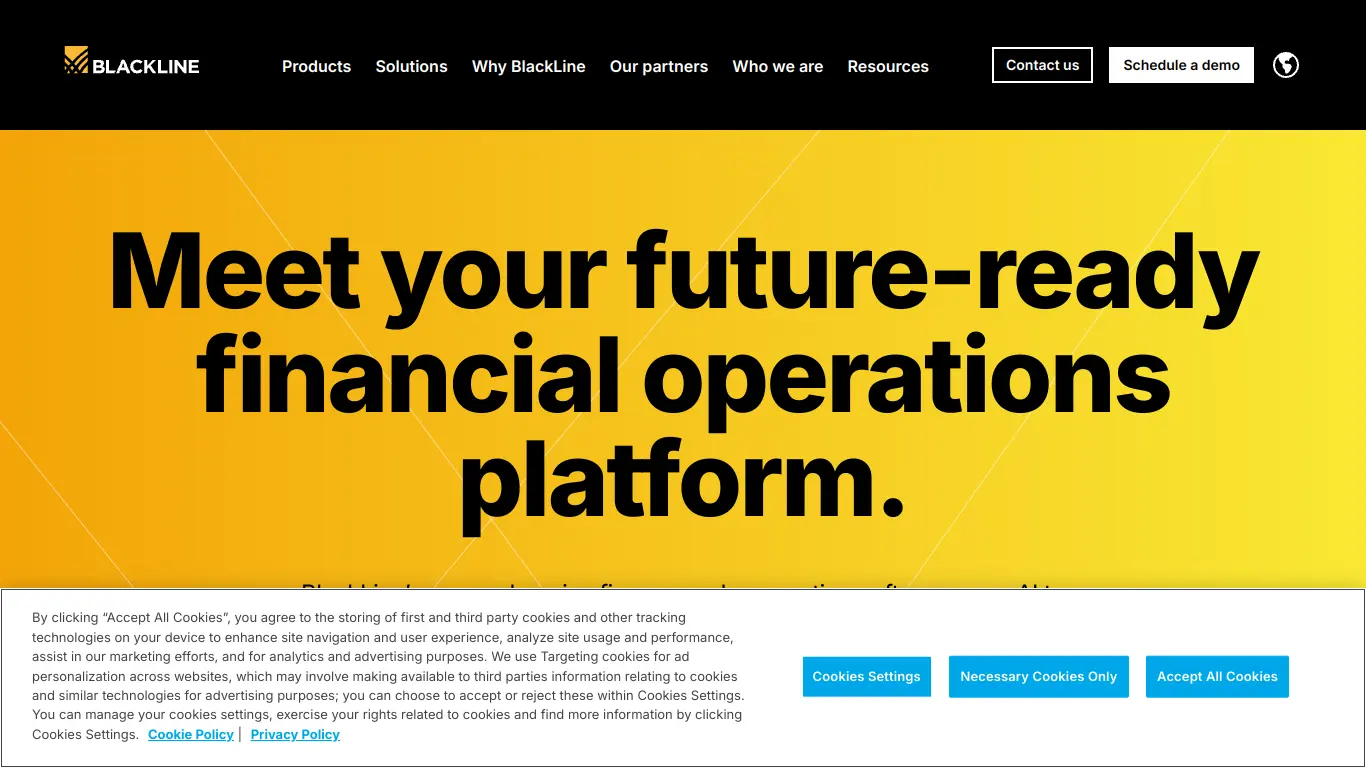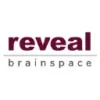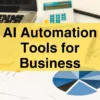BlackLine automates financial close processes, account reconciliations, and controls to increase efficiency and accuracy for accounting teams.
Introduction to BlackLine
If you’re struggling with manual accounting processes, drowning in spreadsheets, or worried about financial closing accuracy, you’re not alone. Many accounting teams face these challenges daily, leading to burnout, errors, and compliance risks. That’s where BlackLine enters the picture, offering a ray of hope for finance professionals seeking to modernize their accounting operations.
What is BlackLine and its Purpose?
BlackLine is a cloud-based financial operations management platform designed to automate and streamline accounting processes. Founded in 2001, BlackLine has evolved into a comprehensive solution that transforms how companies handle their financial close, accounts reconciliation, intercompany accounting, and other critical finance functions.
At its core, BlackLine’s purpose is to modernize accounting by replacing manual, error-prone processes with automated, standardized, and controlled workflows. The platform essentially serves as a centralized hub where accounting teams can collaborate, track tasks, store documentation, and gain visibility into the entire financial close process.
BlackLine isn’t just another accounting software—it’s a strategic tool that helps organizations enhance financial controls, reduce compliance risks, improve efficiency, and free up finance professionals to focus on more strategic activities rather than mundane data entry and reconciliations.
Who is BlackLine Designed For?
BlackLine is primarily designed for mid-size to large enterprises across various industries, though its solutions can be scaled to meet the needs of growing businesses as well. The platform serves several key user groups:
- Finance and Accounting Teams: Staff accountants, controllers, and finance managers who handle day-to-day accounting operations benefit from BlackLine’s automation capabilities.
- Financial Leadership: CFOs and finance directors gain enhanced visibility into financial processes and improved control over reporting.
- Compliance Officers: Teams responsible for SOX compliance and other regulatory requirements appreciate BlackLine’s robust control framework and audit trail features.
- Auditors: Both internal and external auditors benefit from the centralized documentation and transparent processes.
- IT Departments: As a cloud-based solution, BlackLine reduces the burden on IT teams who would otherwise need to maintain on-premises accounting systems.
Industry-wise, BlackLine serves various sectors including manufacturing, retail, healthcare, financial services, technology, and professional services—essentially any organization with complex accounting needs and a desire to modernize financial operations.
Getting Started with BlackLine: How to Use It
Getting started with BlackLine involves a structured implementation process that typically includes:
- Assessment and Planning: BlackLine‘s team works with your organization to understand your current processes, pain points, and goals for automation.
- Implementation and Configuration: The platform is configured to match your specific accounting workflows, chart of accounts, and reporting requirements.
- Data Migration: Historical data is imported into the system to ensure continuity of operations.
- User Training: Comprehensive training is provided to ensure your team can effectively use the platform.
- Go-Live and Support: BlackLine provides ongoing support during the transition period and beyond.
Using BlackLine typically follows this workflow:
- Tasks are automatically generated based on close calendars
- Reconciliations and other accounting activities are performed within the platform
- Documentation is attached directly to relevant transactions
- Supervisors review and approve work
- Dashboards provide real-time visibility into progress
- Reports and analytics offer insights for continuous improvement
The platform’s intuitive interface allows users to navigate between different modules based on their responsibilities, with role-based access ensuring proper segregation of duties.
BlackLine’s Key Features and Benefits
Core Functionalities of BlackLine
BlackLine offers a suite of integrated solutions that work together to modernize financial operations:
- Account Reconciliations: Automates the reconciliation process, from data import to review and approval, with standardized templates and workflows.
- Task Management: Centralizes the coordination of period-end close activities with automated task creation, assignment, and status tracking.
- Transaction Matching: Automatically matches transactions from multiple sources, highlighting exceptions that require human review.
- Journal Entry: Streamlines the creation, review, approval, and posting of journal entries with built-in validation rules.
- Variance Analysis: Identifies and explains fluctuations in account balances, helping to spot trends and anomalies.
- Intercompany Hub: Manages complex intercompany transactions, eliminating discrepancies before they impact the financial close.
- Compliance: Provides documentation and control frameworks that support audit requirements and regulatory compliance.
- Consolidation Integrity Manager: Ensures accuracy of consolidated financial statements by validating data across sources.
- Smart Close: Extends automation capabilities to ERP systems like SAP for a more comprehensive close automation.
- Cash Application: Streamlines the order-to-cash process by automating cash application to open receivables.
Each module integrates seamlessly with the others, creating a comprehensive financial operations management system.
Advantages of Using BlackLine
Implementing BlackLine delivers numerous benefits that transform accounting operations:
Efficiency Gains
- 🕒 Reduces close cycle times by up to 50%
- 📉 Decreases manual effort by automating routine tasks
- 🔄 Eliminates duplicate work through standardized processes
Risk Reduction
- 🛡️ Enhances financial controls and segregation of duties
- 📊 Improves accuracy by reducing manual errors
- 🔍 Creates audit trails that simplify compliance
Strategic Value
- 📈 Frees up finance teams for value-added analysis
- 💡 Provides insights through real-time dashboards and reports
- 🌐 Supports global operations with multi-currency and multi-entity capabilities
Operational Improvements
- ☁️ Cloud-based platform allows secure access from anywhere
- 📱 Mobile capabilities support remote work scenarios
- 🤝 Facilitates collaboration across departments and geographies
According to BlackLine’s customer data, organizations typically see:
- 25-70% reduction in time spent on reconciliations
- 90% decrease in manual journal entries
- 50-62% faster financial close processes
Main Use Cases and Applications
BlackLine addresses several critical financial processes:
Period-End Close
BlackLine streamlines the month-end, quarter-end, and year-end closing processes by automating task management, reconciliations, and reporting. This ensures deadlines are met consistently while maintaining accuracy.
Continuous Accounting
Rather than cramming all reconciliation activities into the period-end, BlackLine enables a continuous accounting approach where tasks are distributed throughout the period, reducing end-of-month pressure.
Financial Transformation Initiatives
Organizations undergoing finance transformation use BlackLine as a key component in modernizing their accounting functions, often in conjunction with ERP implementations or upgrades.
Mergers and Acquisitions
BlackLine facilitates the integration of financial systems during M&A activities, providing a consistent platform for reconciliations and financial close across newly combined entities.
Regulatory Compliance
Companies facing SOX requirements, IFRS standards, or industry-specific regulations use BlackLine to maintain robust controls and documentation.
Audit Preparation
BlackLine simplifies audit preparation by maintaining organized documentation, standardized processes, and clear audit trails that external auditors can easily review.
Exploring BlackLine’s Platform and Interface
User Interface and User Experience
BlackLine’s interface is designed with finance professionals in mind, balancing comprehensive functionality with usability:
Dashboard-Centric Design
The platform greets users with role-specific dashboards that provide immediate visibility into tasks, status updates, and key metrics. These dashboards serve as command centers where users can:
- Monitor completion rates for reconciliations and tasks
- View pending approvals
- Identify bottlenecks in the close process
- Track key performance indicators
Intuitive Navigation
BlackLine uses a logical organizational structure with:
- Clear menu hierarchies for different functional areas
- Consistent layout patterns across modules
- Breadcrumb navigation for complex workflows
- Quick-access shortcuts for frequently used features
Task-Oriented Workflows
The platform guides users through standardized workflows that ensure consistency and completeness. For example, the reconciliation process follows a structured path from preparation to review and approval, with built-in validation checks along the way.
Search and Filter Capabilities
Users can quickly locate specific accounts, reconciliations, or tasks using robust search and filtering options. This is particularly valuable for organizations managing thousands of accounts.
Document Management
The integrated document repository makes it easy to attach supporting documentation directly to reconciliations, journal entries, and other financial activities, eliminating the need for separate document storage systems.
Collaboration Tools
Built-in commenting, notification, and assignment features facilitate communication between team members, reducing email traffic and creating clear accountability.
Platform Accessibility
BlackLine’s cloud-based approach offers flexibility in how users access and interact with the system:
Multi-Device Support
- 💻 Desktop browsers for detailed work
- 📱 Mobile applications for on-the-go approvals and status checks
- 🔄 Responsive design that adapts to different screen sizes
Integration Capabilities
BlackLine connects smoothly with other financial systems:
- Direct integration with major ERP systems like SAP, Oracle, and NetSuite
- API access for custom integrations with other financial applications
- Import/export functionality for data exchange with legacy systems
Security and Compliance Features
The platform incorporates robust security measures:
- Role-based access controls that limit what users can see and do
- Multi-factor authentication options
- Detailed audit logs of user activities
- SOC 1, SOC 2, and ISO 27001 compliance
Accessibility Considerations
BlackLine has worked to make its platform accessible to users with disabilities, incorporating features such as:
- Screen reader compatibility
- Keyboard navigation options
- Color contrast settings
- Text-to-speech capabilities
This combination of intuitive design and flexible access options makes BlackLine suitable for diverse accounting teams, regardless of technical expertise or working environment.
BlackLine Pricing and Plans
Subscription Options
BlackLine operates on a subscription-based model with pricing structured according to:
Module-Based Pricing
BlackLine’s modular approach allows companies to select the specific functionalities they need:
- Core accounting modules (Account Reconciliations, Task Management)
- Advanced modules (Transaction Matching, Journal Entry, Intercompany)
- Specialized solutions (Smart Close, Cash Application)
Volume-Based Considerations
Pricing typically scales based on:
- Number of users accessing the system
- Volume of accounts being reconciled
- Number of entities or business units
- Transaction volumes for matching and processing
Implementation and Services
Beyond the software subscription, companies should budget for:
- Initial implementation services
- Configuration assistance
- Training programs
- Premium support options
While BlackLine doesn’t publish standard pricing on their website, industry reports suggest that implementations typically range from $50,000 for smaller deployments to several hundred thousand dollars for large, complex enterprises with multiple modules.
Free vs. Paid Features
BlackLine is an enterprise-grade solution without a permanent free tier, but they do offer several ways to explore the platform before committing:
Evaluation Options
- 🔍 Guided product demonstrations
- 🧪 Custom proof-of-concept implementations
- 🎬 Recorded demos and tutorials
- 📊 ROI assessment tools
Paid Components
The full BlackLine solution includes:
- Base platform license
- Module-specific subscriptions
- User access licenses
- Implementation services
- Training and enablement
- Premium support options
Value-Added Complimentary Resources
While not offering free software usage, BlackLine provides valuable resources at no cost:
- Educational webinars and thought leadership content
- BlackLine Community access for customers
- Basic knowledge base articles
- Industry benchmark reports
- Best practice guides
Organizations interested in BlackLine typically engage directly with their sales team for a customized quote based on specific requirements and scope of implementation.
BlackLine Reviews and User Feedback
Pros and Cons of BlackLine
Based on analysis of customer reviews across multiple platforms, here’s a balanced assessment of BlackLine’s strengths and limitations:
Pros:
- Automation Excellence: Users consistently praise BlackLine’s ability to automate previously manual reconciliation processes, saving significant time and reducing errors.
- Visibility and Control: The centralized dashboard and reporting capabilities provide unprecedented visibility into the financial close process.
- Audit Trail and Documentation: The comprehensive audit trails and document storage capabilities simplify audit preparation and enhance compliance efforts.
- Customization Options: Users appreciate the flexibility to tailor reconciliation templates, workflows, and reports to their specific business needs.
- User-Friendly Interface: Despite its powerful features, most users find BlackLine relatively intuitive to navigate after initial training.
- Quality Support: Customer support receives high marks for responsiveness and knowledge, particularly for enterprise-level customers.
- Continuous Improvement: Regular updates and new features demonstrate BlackLine’s commitment to product enhancement.
Cons:
- Implementation Complexity: Some users report challenging implementation processes, particularly when integrating with legacy systems.
- Learning Curve: New users may face a moderate learning curve, especially with advanced features like transaction matching.
- Cost Concerns: Multiple reviews mention that BlackLine represents a significant investment that may be difficult to justify for smaller organizations.
- Customization Limitations: While customizable, some users report wanting even more flexibility in certain areas of the platform.
- Report Building Complexity: Creating custom reports sometimes requires more technical knowledge than users expect.
- Mobile Functionality: Some users feel the mobile experience isn’t as robust as the desktop version.
- Integration Gaps: While major ERP systems are well-supported, integrations with niche financial systems can be challenging.
User Testimonials and Opinions
Financial professionals across industries have shared their experiences with BlackLine:
“BlackLine transformed our month-end close from a two-week marathon to a streamlined five-day process. The automation of reconciliations alone saved each accountant about 20 hours per month.” — Financial Controller, Manufacturing Industry
“The visibility BlackLine provides has been game-changing. I can now see exactly where we are in the close process at any moment, identify bottlenecks, and reallocate resources accordingly.” — Director of Accounting, Retail Company
“Implementation was more complex than we anticipated, but once we got over that hurdle, the efficiencies gained have been worth it. We’ve reduced our reconciliation time by over 60%.” — Accounting Manager, Healthcare Organization
“The audit trail functionality has made our SOX compliance efforts much more straightforward. Our auditors now have direct access to the system, which has reduced back-and-forth questions by at least 40%.” — Compliance Director, Financial Services
Industry analysts also recognize BlackLine’s impact:
- Gartner has consistently positioned BlackLine as a leader in financial close solutions
- Forrester Research highlights BlackLine’s strength in automation and control
- G2 shows BlackLine with a 4.5/5 average rating across hundreds of verified users
According to BlackLine’s own customer satisfaction surveys, 95% of users report improved efficiency in their close process after implementation, and 92% cite better visibility into financial operations.
BlackLine Company and Background Information
About the Company Behind BlackLine
BlackLine’s journey from startup to industry leader reflects its commitment to transforming financial operations:
Company History
Founded in 2001 by Therese Tucker, BlackLine began with a simple mission: to automate the financial close process and help accounting teams work more efficiently. This vision emerged from Tucker’s own experiences as a financial software executive and her recognition of the limitations in existing tools.
Key milestones in BlackLine’s evolution include:
- 2001: Founded in Los Angeles, California
- 2008: Secured initial investment from private equity
- 2013: Received strategic investment from Silver Lake Sumeru
- 2016: Completed initial public offering (IPO) on NASDAQ (BL)
- 2018: Acquired Runbook to enhance SAP integration capabilities
- 2021: Celebrated 20 years of financial innovation
- 2023: Continued global expansion with offices across North America, Europe, Asia, and Australia
Leadership and Culture
BlackLine is led by a team of experienced executives with backgrounds in finance, technology, and enterprise software. The company’s culture emphasizes:
- Customer-centric innovation
- Technical excellence
- Diversity and inclusion
- Work-life balance
- Continuous learning
Market Position
BlackLine has established itself as a leader in financial close automation:
- 4,000+ customers worldwide
- Used by more than 300,000 finance professionals
- Serves clients in over 130 countries
- Partners with major accounting firms and technology providers
- Recognized by industry analysts as a leader in its category
Corporate Responsibility
BlackLine demonstrates commitment to corporate citizenship through:
- Environmental initiatives and sustainability goals
- Diversity programs and inclusive hiring practices
- Community involvement and charitable contributions
- Ethical business practices and transparency
The company continues to evolve its platform in response to changing financial regulations, emerging technologies, and customer needs, maintaining its position as an innovator in financial operations management.
BlackLine Alternatives and Competitors
Top BlackLine Alternatives in the Market
The financial close automation and account reconciliation market offers several alternatives to BlackLine, each with distinct strengths:
| Alternative | Primary Focus | Best For | Pricing Model |
|---|---|---|---|
| Trintech | Financial close management with strong transaction matching | Large enterprises with complex reconciliation needs | Subscription-based, enterprise pricing |
| Oracle FCCS | Financial consolidation and close process management | Organizations already invested in Oracle ecosystem | Module-based licensing within EPM suite |
| FloQast | Close management with audit-ready financials | Mid-market companies seeking streamlined close management | Per-user subscription pricing |
| ReconArt | Transaction reconciliation and matching | Organizations focused primarily on reconciliation automation | Modular pricing based on volume and features |
| Redwood | Finance automation with SAP specialization | SAP customers seeking to automate financial processes | Enterprise pricing model |
| Workiva | Financial reporting and compliance | Companies focused on financial reporting and SEC filings | Platform + user licensing model |
| Sage Intacct | Cloud financial management with reconciliation features | Growing mid-market companies | Subscription-based with modular components |
For organizations considering alternatives to BlackLine, it’s important to evaluate solutions based on:
- Specific process pain points
- Integration requirements with existing systems
- Budget constraints
- Company size and complexity
- Industry-specific needs
BlackLine vs. Competitors: A Comparative Analysis
When comparing BlackLine to its primary competitors, several key differentiators emerge:
BlackLine vs. Trintech
| BlackLine | Trintech | |
|---|---|---|
| Strengths | Intuitive user interface, strong account reconciliation, comprehensive financial close suite | Robust transaction matching, scalable for very large enterprises |
| Limitations | Can be costly for smaller organizations | Steeper learning curve reported by some users |
| Implementation | Generally more standardized approach | Often requires more customization |
| Customer Base | Broad range across industries and sizes | Especially strong in larger enterprises |
BlackLine vs. FloQast
| BlackLine | FloQast | |
|---|---|---|
| Strengths | Comprehensive feature set, deep reconciliation capabilities | Ease of implementation, QuickBooks/NetSuite integration, checklist-based approach |
| Limitations | More complex implementation | Less robust in detailed reconciliation automation |
| Price Point | Higher investment | More affordable for mid-market |
| Focus | End-to-end financial operations | Close management and task tracking |
BlackLine vs. Oracle FCCS
| BlackLine | Oracle FCCS | |
|---|---|---|
| Strengths | Purpose-built for reconciliation and close, vendor independence | Strong consolidation capabilities, integration with Oracle suite |
| Limitations | Less focus on financial consolidation | Less specialized in reconciliation details |
| Best Fit | Companies seeking best-of-breed approach | Oracle-centric organizations |
| Deployment | Cloud-native solution | Cloud or hybrid options |
Industry Analyst Comparison
According to recent Gartner and Forrester analyses:
- BlackLine leads in user satisfaction metrics
- Trintech offers comparable functionality but with different user experience
- FloQast provides faster implementation for mid-market needs
- Oracle FCCS has advantages for organizations already committed to Oracle ecosystem
When selecting between BlackLine and competitors, organizations should consider:
- Specific process requirements and priorities
- Existing technology investments
- Available implementation resources
- Budget constraints
- Growth trajectories
- Need for specialized vs. integrated solutions
Most organizations benefit from structured evaluations, including demos, sandbox testing, and reference checks with similar companies before making a final decision.
BlackLine Website Traffic and Analytics
Website Visit Over Time
BlackLine’s web presence shows consistent growth, reflecting increasing interest in financial automation solutions:
📊 Monthly Website Traffic Trend (2022-2023)
- Average monthly visitors: ~300,000-400,000
- Year-over-year growth: Approximately 15-20%
- Peak traffic periods: Typically coincide with quarter-end periods and major accounting conferences
- Traffic spikes: Notable increases during new product announcements and annual BlackLine user conference (BeyondTheBlack)
The website traffic patterns show seasonal variations that align with financial close cycles, with increased activity in January-February (year-end closing) and each quarter-end period.
Geographical Distribution of Users
BlackLine’s global reach is evident in its website visitor demographics:
🌎 Top Visitor Countries
- United States (45-50%)
- United Kingdom (8-10%)
- Canada (6-8%)
- Australia (5-7%)
- Germany (4-6%)
- France (3-5%)
- Singapore (2-4%)
- India (2-4%)
- Netherlands (2-3%)
- Japan (1-3%)
The geographic distribution reflects BlackLine’s market penetration in regions with strong regulatory environments and sophisticated financial operations. Emerging market interest has been growing, particularly in Asia-Pacific and Latin American regions.
Main Traffic Sources
Understanding how users discover BlackLine provides insight into the company’s market position:
📱 Traffic Source Breakdown
- Organic Search: 40-45% (dominated by financial close automation and account reconciliation keywords)
- Direct Traffic: 25-30% (indicating strong brand recognition)
- Referral Traffic: 10-15% (primarily from accounting publication sites and partner networks)
- Social Media: 5-8% (LinkedIn being the dominant channel)
- Paid Search: 5-7% (targeted campaigns for specific solutions)
- Email Marketing: 3-5% (newsletter and event promotions)
The high percentage of organic search traffic suggests strong SEO performance for key financial automation terms, while the substantial direct traffic indicates BlackLine has established significant brand awareness in its target market.
Top referring domains include:
- Major accounting and finance publications
- Big Four accounting firm websites
- Financial technology review platforms
- Industry association websites
- Partner ecosystem pages
This traffic analysis demonstrates BlackLine’s established position in the financial close automation space, with a strong digital presence that continues to expand globally.
Frequently Asked Questions about BlackLine (FAQs)
General Questions about BlackLine
What exactly does BlackLine do?
BlackLine provides cloud-based solutions that automate and control financial close processes, including account reconciliations, task management, transaction matching, journal entries, and intercompany accounting. The platform helps organizations replace manual, spreadsheet-based processes with automated, standardized workflows.
Is BlackLine an ERP system?
No, BlackLine is not an ERP system. Instead, it complements ERP systems by providing specialized functionality for financial close processes that most ERPs don’t handle comprehensively. BlackLine integrates with major ERP systems like SAP, Oracle, NetSuite, and Microsoft Dynamics.
How long does it take to implement BlackLine?
Implementation timelines vary based on company size, complexity, and modules selected. Typical implementations range from:
- Small/focused implementations: 2-3 months
- Mid-size companies: 3-6 months
- Large enterprises with multiple modules: 6-12+ months
Does BlackLine work with my existing financial systems?
BlackLine is designed to integrate with most major financial systems. It offers pre-built connectors for popular ERPs and can also import data from other systems using flat files, APIs, or custom integrations developed through BlackLine’s professional services team.
Feature Specific Questions
What types of reconciliations can BlackLine automate?
BlackLine can automate various reconciliation types, including:
- Balance sheet account reconciliations
- Bank reconciliations
- Credit card reconciliations
- Intercompany reconciliations
- Suspense account reconciliations
- Clearing account reconciliations
- Sub-ledger to general ledger reconciliations
Can BlackLine handle multiple currencies and entities?
Yes, BlackLine is designed for multinational organizations and supports multiple currencies, entities, and languages. The platform can convert transactions to reporting currencies and consolidate data across various legal entities while maintaining appropriate segregation and controls.
How does BlackLine improve the audit process?
BlackLine enhances audits through:
- Centralized documentation storage
- Standardized reconciliation templates
- Comprehensive audit trails of all system activities
- Automated controls and validations
- Direct auditor access to evidence and documentation
- Consistent processes across all entities
Can BlackLine integrate with our document management system?
Yes, BlackLine offers integration capabilities with popular document management systems. Additionally, BlackLine has its own document repository where supporting documentation can be attached directly to reconciliations, journal entries, and other financial activities.
Pricing and Subscription FAQs
How is BlackLine priced?
BlackLine uses a subscription-based pricing model that typically considers:
- Modules licensed
- Number of users
- Volume of accounts reconciled
- Number of legal entities
- Implementation services
Pricing is customized for each organization based on specific requirements.
Is there a minimum contract period?
BlackLine typically requires minimum one-year contracts, with many enterprises opting for multi-year agreements to secure favorable pricing. Renewal terms are generally specified in the initial contract.
Can we add modules or users after initial implementation?
Yes, BlackLine’s modular approach allows organizations to start with core functionalities and expand over time. Additional modules, users, and entities can be added to existing subscriptions, often coinciding with contract renewal periods.
Is training included in the subscription cost?
Basic training is typically included during implementation, while advanced or specialized training may incur additional costs. BlackLine also offers a certification program and continuing education options for ongoing user development.
Support and Help FAQs
What support options does BlackLine provide?
BlackLine offers tiered support options:
- Standard support: Business hours assistance via email and portal
- Premium support: Extended hours and faster response times
- Elite support: 24/7 coverage with dedicated resources
Is there a user community for BlackLine customers?
Yes, BlackLine maintains an active user community where customers can share best practices, ask questions, access resources, and provide product feedback. The community includes forums, knowledge base articles, and region-specific user groups.
How frequently is BlackLine updated?
BlackLine releases product updates approximately 4-6 times per year. These updates are automatically applied to the cloud platform, minimizing disruption to users. Major feature releases are typically accompanied by advance notifications and training materials.
How can we get help with complex configurations or custom needs?
BlackLine offers several options for specialized assistance:
- Professional services for complex configurations
- Solution architecture consulting for enterprise implementations
- Partner network of experienced consultants
- BlackLine Labs for custom development needs
Conclusion: Is BlackLine Worth It?
Summary of BlackLine’s Strengths and Weaknesses
After a comprehensive analysis of BlackLine’s features, capabilities, user feedback, and market position, here’s a balanced assessment of its value proposition:
Key Strengths:
- Automation Excellence: BlackLine excels at automating previously manual reconciliation processes, delivering significant time savings and error reduction. Organizations routinely report 50%+ efficiency improvements.
- Purpose-Built Design: Unlike generic tools or ERP modules, BlackLine was specifically designed for financial close processes, resulting in more tailored functionality for accounting teams.
- Visibility and Control: The platform provides unprecedented transparency into financial close processes, enabling better management, resource allocation, and bottleneck identification.
- Compliance and Audit Support: The structured workflows, documentation management, and audit trails substantially reduce compliance burdens and simplify audit preparation.
- Ecosystem Integration: BlackLine’s connectivity with major ERP systems and extensive partner network ensures it fits within complex financial technology landscapes.
Notable Limitations:
- Investment Required: The comprehensive nature of BlackLine comes with corresponding costs that may be challenging for smaller organizations to justify.
- Implementation Complexity: Achieving full value requires thorough implementation that typically takes months and requires dedicated resources.
- Change Management Needs: Success with BlackLine demands process changes and user adoption that some organizations find challenging.
- Customization Balancing: While flexible, some organizations report wanting even more customization options for specialized processes.
Final Recommendation and Verdict
BlackLine delivers exceptional value for medium to large organizations with complex financial close processes, multiple entities, significant reconciliation volumes, or stringent compliance requirements. Its ROI case is strongest for:
- Companies struggling with manual processes: Organizations still relying heavily on spreadsheets for reconciliations and close tracking will see dramatic improvements.
- Growth-stage businesses: Companies experiencing rapid growth or expansion into new markets benefit from BlackLine’s scalability and standardization capabilities.
- Organizations with compliance burdens: Businesses in regulated industries or public companies with SOX requirements find BlackLine’s control framework particularly valuable.
- Multinational enterprises: Companies operating across multiple countries, currencies, and entities leverage BlackLine to create consistency while accommodating local requirements.
- Finance transformation initiatives: Organizations modernizing their finance function find BlackLine a key component in their digital finance strategy.
Is BlackLine Worth It? For most mid-sized and enterprise organizations, the answer is a clear yes. The platform’s ability to:
- Reduce close cycle times by 50%+
- Free up accounting staff for higher-value work
- Improve financial controls and reduce risk
- Create standardized global processes
- Simplify audits and compliance efforts
…delivers a compelling return on investment that typically exceeds the subscription and implementation costs within 12-24 months.
For smaller organizations or those with very simple financial processes, the full BlackLine suite may be more than needed. These companies might consider starting with specific modules or exploring mid-market alternatives.
Ultimately, BlackLine has established itself as a leader in financial close automation by solving real, persistent problems for accounting teams. For organizations struggling with manual reconciliations, visibility gaps, or close inefficiencies, BlackLine offers a proven path to modernization that transforms not just processes, but the entire finance function’s strategic value.





















